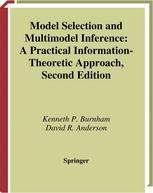

Most ebook files are in PDF format, so you can easily read them using various software such as Foxit Reader or directly on the Google Chrome browser.
Some ebook files are released by publishers in other formats such as .awz, .mobi, .epub, .fb2, etc. You may need to install specific software to read these formats on mobile/PC, such as Calibre.
Please read the tutorial at this link: https://ebookbell.com/faq
We offer FREE conversion to the popular formats you request; however, this may take some time. Therefore, right after payment, please email us, and we will try to provide the service as quickly as possible.
For some exceptional file formats or broken links (if any), please refrain from opening any disputes. Instead, email us first, and we will try to assist within a maximum of 6 hours.
EbookBell Team

0.0
0 reviewsWe wrote this book to introduce graduate students and research workers in various scienti?c disciplines to the use of information-theoretic approaches in the analysis of empirical data. These methods allow the data-based selection of a “best” model and a ranking and weighting of the remaining models in a pre-de?ned set. Traditional statistical inference can then be based on this selected best model. However, we now emphasize that information-theoretic approaches allow formal inference to be based on more than one model (m- timodel inference). Such procedures lead to more robust inferences in many cases, and we advocate these approaches throughout the book. The second edition was prepared with three goals in mind. First, we have tried to improve the presentation of the material. Boxes now highlight ess- tial expressions and points. Some reorganization has been done to improve the ?ow of concepts, and a new chapter has been added. Chapters 2 and 4 have been streamlined in view of the detailed theory provided in Chapter 7. S- ond, concepts related to making formal inferences from more than one model (multimodel inference) have been emphasized throughout the book, but p- ticularly in Chapters 4, 5, and 6. Third, new technical material has been added to Chapters 5 and 6. Well over 100 new references to the technical literature are given. These changes result primarily from our experiences while giving several seminars, workshops, and graduate courses on material in the ?rst e- tion.